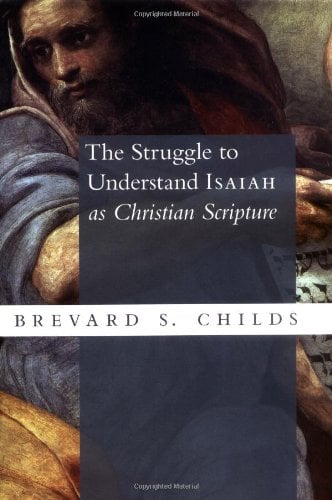Strangely, Child’s jumps nearly 900 years to his next major interpreter, Aquinas. How is it even possible that there is no real discussion of Augustine’s voluminous dealings with the Biblical text, including Isaiah? Or even someone like Bede? And why include a minor figure like Nicholas of Lyra who really adds little to the discussion? However we answer these questions, there can be no cavil with giving good treatment to Aquinas.
The influence of Thomas Aquinas (ca. 1225-74 A.D.) compared to some of these earlier church fathers, not including Augustine, can hardly be over-estimated. I recently went to a Christology Conference at the Dominican Centre at Catholic University in D.C. to present a paper. To my amazement, most of what went on was interpreting Christology through the lens of Thomist theology. Thomas Aquinas is alive and well in this nation’s capital.
As profound a theologian as Aquinas was, it is interesting, as Childs notes, that he culminated a trend in Biblical interpretation that “replaced the interest in the figurative senses with a new focus on the primacy of the literal/historical sense” and with Thomas this involved “replacing the neo-Platonic heritage of Augustine with that of Aristotle.” Notice that there is still Greek philosophy used as a guide or touchstone in these matters, not to mention Greek rhetorical categories and influences. Thomas stressed that “no doctrinal implication be drawn that deviate[s] from the literal sense”…Nothing essential to the dogmatic content of the faith can be expected from figurative interpretations.”
Aquinas affirms that God is the author of the Bible, and that the human authors can be called ‘instrumental causes’ of its production. There is no tension or contradiction between divine revelation on one hand, and the human author’s efforts on the other. Thomas is not a child of the Enlightenment born out of due season. It is important however to note that Thomas discusses the human author’s intention as well as the divine intention. The literal sense of the text is that which the human author intends, it would seem.
Thomas wrote his Isaiah commentary while in Paris between 1269-72. Since an autographed copy of his original work is in the Vatican, here text criticism is not necessary to recover the original. Aquinas is in agreement with Jerome that Isaiah excels the other prophets, is clear and eloquent in his diction and is more of an evangelist than just a prophet. The content of the book is said to be the coming of Christ and the calling of the nations, but this events, which were future to Isaiah, are mysteries perceived from a distance and are rather concealed in the text itself, and requiring faith to see and understand them. Nevertheless, Thomas spends no little time taking issue with previous allegorizing of the text of Isaiah, instead lifting up its historical sense. As Childs says “Viewing Thomas’s commentary on Isaiah as a whole,…the great bulk of his interpretation falls under the rubric ad litteram.” The great problem with Thomas is that he is untrained in either Hebrew or Greek, and so he is dependent on for instance Jerome.
The commentary is highly organized, and Thomas gives great and detailed attention to issue of literary context and structure, and spends a good deal of time, much as in a rabbinic commentary, by citing a bunch of other texts which the reader is expected to compare with Isaiah. He also spends a remarkable amount of time on geographical, zoological, and chronological details as well. Thomas also includes the use of metaphor as within the category of attending to the literal sense of the text (see Is. 5). But when he gets to texts like Is. 7,9 he sees these as literally straightforward predictions of the coming of Christ. Once having affirmed the literal referent of such a prophecy, he is prepared to supplement this by interpreting Jer. 31.22 and Ezek. 44.2 as allegorical references to the virginal conception. Interestingly, in dealing with Is. 11 he sees this also as referring to Christ, but in a figurative way.
Turning to Is. 40-66 Thomas does recognize that something different is going on here, and he does indeed refer the deliverance spoken of in the first instance to refer to the return from Babylonian exile at the hands of Cyrus. But he treats Cyrus in Is. 44-49 both as a historical figure and also a type of Christ. Similarly, he admits that in the first instance the servant in Is. 42 and 49 is Israel, but mostly he interprets such passages Christologically, and his dealing with Is. 52-53 could be called a short course in Christian theological reflection on the death of Jesus.
Thomas is certainly one who emphasizes the literal meaning of the Biblical text, but he could get to the figurative meaning of the text through the use of an inter-textual reference or two. And there is both a plus and a minus to his use of Aristotle’s categories to make sense of the text. On the plus side is the fact that it doesn’t try to radically distinguish the literal and deeper meanings of the text. Many meanings can be present in the literal sense of one prophetic passage. It’s not an either or situation.













